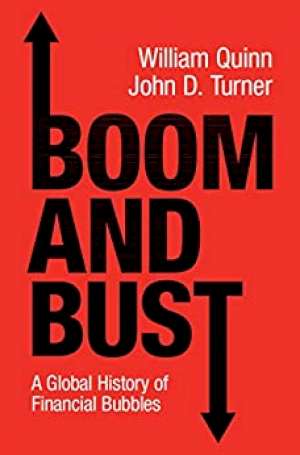26 November 2020
Boom and Bust:
A Global Financial History of Bubbles
William Quinn and John D Turner
2020, Cambridge University Press, 296 pages,
ISBN 9781108421256
Reviewer: Keith Wade, Schroders

Bubbles in housing and stock markets make headlines and capture the public imagination like few other financial events. The prospect of making a fortune pulls more and more people into the market driven by the fear of missing out as they witness friends and neighbours making extraordinary financial gains in the gold rush. Fundamental analysis falls by the wayside and only returns after the inevitable crash and the sobering effect of losses or, in some cases, complete financial ruin.
Bubbles are damaging not just to individuals, but to the wider economy as resources are misallocated, witness the empty houses in the US, UK, Ireland and Spain following the boom and bust created by the sub-prime housing bubble. The same bubble also significantly damaged the reputation of the financial sector which lost public confidence.
In this analysis William Quinn and John Turner take us on an historical tour starting in 1720 with the South Sea bubble and encompassing the railway mania of the nineteenth century, the Wall Street crash of 1929 and the more recent subprime bubble. En route they cover Japan in the 1980s, the dot-com bubble at the turn of the century, China in the 2000s and lesser known bubbles such as the British bicycle mania of the 1890s.
The authors draw together the common factors behind each event and create a Bubble Triangle where the three key ingredients of any bubble: loose money, marketability and speculation are pulled together. However, as the authors concede, spotting a bubble is not easy and the Triangle only shows the pre-conditions for what is needed as bubbles, which are akin to a raging financial fire, need a spark to come to life.
Part of the value of the book lies in the analysis of these sparks and the authors identify two which stand out. The first is government policy, with the book showing how well -intentioned measures can have adverse effects – one example being the recent subprime crisis where political efforts in the 1980s and 90s to encourage greater home ownership for lower income groups led to a loosening of bank lending standards. Later the securitisation of mortgage loans ensured the marketability for speculation to take place, whilst loose monetary policy meant that credit was available to fuel the boom. “Greedy bankers” were part of this story, but the origins lie deeper.
The second spark is new technology. New innovations are exciting and often capture the public imagination. Determining their impact on business and long-run profitability is fraught with difficulty. Consequently, the door is open for speculation which, accompanied by the remaining sides of the triangle, can create a bubble. The dot-com boom is the classic example and today the bubble debate continues as the technology sector (or more precisely the FAANG stocks) leads US equities higher.
Not all bubbles are damaging and in examining the consequences of each the authors note the value (albeit with hindsight) of the dot-com boom and the earlier railway mania and bicycle booms. All provided capital to fund new innovation which created products of lasting social value. The more damaging bubbles tend to be sparked by government policy and often involve significant bank leverage with the South Sea, Japanese and sub-prime cases being the main examples. The losses incurred by the banking sector then turn the bursting of the bubble into a systemic crisis affecting the whole economy.
“Boom and bust” is a good analysis with a fascinating historical narrative, but why should SPE members read it? Principally because bubbles are becoming more frequent with one occurring every six years since 1990. After the Wall Street crash of 1929 there were no bubbles for 50 years and there were more than a hundred years between the first bubble recorded in the book in 1720 and the second in 1824.
Furthermore, the elements of the bubble triangle are falling into place today. In particular with interest rates close to zero in the US and UK and negative in the Eurozone and Japan, investors are desperately looking for opportunities to deploy their cash. Meanwhile, inflation remains benign and central banks are under pressure to keep rates low to help governments fund the cost of the pandemic. The stage is set for the next bubble – all it needs is a spark.
